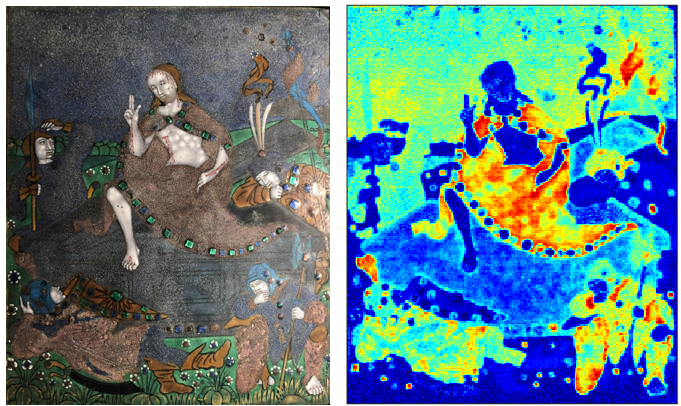The deterioration of Limoges enamels in Museum Collections
Primary author: Dr Margareth Read. Co authors: Dr Andrew Meek, Denise Ling, Dr Capucine Korenberg and Prof Haida Liang.
What are Limoges enamels?
Painted Limoges enamels are the richest surviving corpus of medieval metalwork and were renowned throughout Europe in the Middle Ages. Limoges enamels consist of multiple glass layers painstakingly applied over copper plates. Unfortunately, many of these enamels were made with what turned out to be unstable glass, leading to weeping and crizzling on their surface. Crizzling manifests itself as minute surface cracks, which over time grow and penetrate the whole body of the glass, leading to its physical collapse. This process, commonly known as “glass disease”, is not fully understood and it can be difficult to detect the early stages of glass disease in Limoges enamels.
It is possible to slow down deterioration in objects made of unstable glass by storing them in enclosures with tightly controlled environmental conditions. As it is expensive to set up and maintain such enclosures, intervention needs to be prioritised and only actively deteriorating enamels can be stored in this way.
The research
A research project between Nottingham Trent University, The British Museum and the Arts and Humanities Research Council has created a better understanding of the deterioration mechanism in Limoges enamels and has found a convenient and rapid method to assess their conditions. It used non-invasive analytical techniques to show that the chemical deterioration of glass resulted in subsurface structural damage observed non-invasively by Optical Coherence Tomography (OCT) is strongly linked with its level of hydration. This in turn can be visualised using shortwave infrared hyperspectral imaging (SWIR-HSI). In particular, SWIR-HSI has been used to produce hydration maps for individual enamels and assess the level of glass deterioration.
Societal challenges
The project addresses the sustainable development societal challenge identified by the NHSF research working group. This study contributes to sustainable development by increasing the understanding and longevity of Limoges enamels through research into the deterioration processes to adequately manage the requirements for care and conservation, so they can continue to enrich people’s lives through museum display for future generations.
Impact of initiative
The work highlights the importance of scientific techniques for the analysis of Limoges enamels, to diagnose early warning signs of deterioration and to increase the longevity of the enamels through careful management, for future generations. The research identified gaps in the identification, understanding and knowledge of the deterioration mechanisms of Limoges enamels, and explained the need for scientific analysis of the glass. The work has led to fast mapping analysis of the enamels to quickly identify areas of deterioration, as well as subsurface analysis to efficiently analyse certain types of deterioration mechanisms. This was influential in raising awareness of how the Limoges enamels can deteriorate and the importance of correct care management for them.
The main beneficiaries of the investigation into Limoges enamels are the public and future generations, the cultural heritage community, conservators and museums. Increased longevity of these objects means they can be carefully stored and displayed in the future. Techniques to help diagnose and identify potentially vulnerable glass will aid conservators and carers within the museums surveying the objects. Further investigations into glass deterioration with new techniques aid the cultural heritage community in glass analysis.
Further information
The project finished in August 2021. You can read more about it here. You can also read an article about the research here.

Limoges enamel from 1510-1520 depicting the Resurrection of Christ (registration number: 1913,1220.7) (left) and its hydration map obtained using shortwave infrared hyperspectral imaging (right). The red areas on the hydration map correspond to chemically very degraded glass. © The Trustees of the British Museum. Shared under a Creative Commons Attribution-NonCommercial-ShareAlike 4.0 International (CC BY-NC-SA 4.0) licence
Contacts:
Dr Capucine Korenberg (ckorenberg@britishmuseum.org) and Prof Haida Liang (haida.liang@ntu.ac.uk).
This case study has been shared under Creative Commons License - CC BY-NC 4.0 (https://creativecommons.org/licenses/by-nc/4.0/)
